|
|
|
|
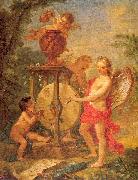 |
Natoire, Charles Joseph
|
|
French, 1700-77
French painter, draughtsman and teacher, active also in Italy. An exact contemporary of Fran?ois Boucher, he was a painter of cabinet pictures, decorations and tapestry cartoons and one of the most adept practitioners of Rococo art in 18th-century France. The greater part of his career was spent in Paris, where he received important commissions from Louis XV as well as from private patrons. In 1751 he accepted the post of Director of the Acad?mie de France in Rome. |
|
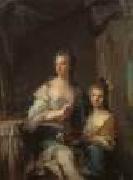 |
NATTIER, Jean-Marc
|
|
French Rococo Era Painter, 1685-1766
Brother of Jean-Baptiste Nattier. As well as being taught by his father, he trained with his godfather, Jean Jouvenet, and attended the drawing classes of the Acad?mie Royale, where in 1700 he won the Premier Prix de Dessin. From around 1703 he worked on La Galerie du Palais du Luxembourg. The experience of copying the work of Rubens does not, however, seem to have had a liberating effect on his draughtsmanship, which was described by the 18th-century collector Pierre-Jean Mariette as 'cold'. Nattier was commissioned to make further drawings for engravers in the early part of his career, including those after Hyacinthe Rigaud's famous state portrait of Louis XIV (1701; Paris, Louvre) in 1710, which indicates that he had established a reputation while he was still quite young. Although he was offered a place at the Acad?mie de France in Rome on the recommendation of Jouvenet, Nattier preferred to remain in Paris and further his career. In 1717 he nevertheless made a trip to Holland, where he painted portraits of Peter the Great and the Empress Catherine (St Petersburg, Hermitage). |
|
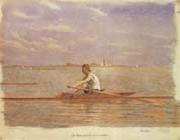 |
NC Wyeth
|
|
American Golden Age Illustrator, 1882-1945
1882-1945,was an American artist and illustrator. He was the star pupil of the artist Howard Pyle, and became one of America's greatest illustrators. During his lifetime, Wyeth created over 3,000 paintings and illustrated 112 books,25 of them for Scribner's, the work for which he is best known. Wyeth was a realist painter just as the camera and photography began to compete with his craft. Sometimes seen as melodramatic, his illustrations were designed to be understood quickly Wyeth who was both a painter and an illustrator, understood the difference, and said in 1908, |
|
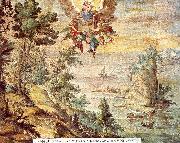 |
Nebbia, Cesare
|
|
Italian, 1536-1614
Italian painter and draughtsman. He was a pupil of GIROLAMO MUZIANO and much influenced by Federico Zuccaro, and Vasari cited him as a promising painter. Between 1562 and 1575 Nebbia was continuously employed in Orvieto, producing altarpieces and frescoes in the cathedral, for example the Marriage at Cana (1569), the Crucifixion (1574) and the Crowning with Thorns (1575; all Orvieto, Mus. Opera Duomo). In Rome, where from 1579 his name appeared in the register of the Accademia di S Luca, he executed an Ecce homo and another Crowning with Thorns (1576; oratory of the Gonfalone), a Noli me tangere (1579; S Maria degli Angeli), decorations in the Sforza Chapel, S Maria Maggiore (1582), Heraclius Taking the Cross (1582-4; Santissimo Crocifisso), the Martyrdom of St Lawrence (1589; S Susanna) and decorations in the Borghese Chapel, Trinit? dei Monti (c. 1590). Under Pope Sixtus V he was responsible, with Giovanni Guerra, for the decorations in the Sistine Library, and he also worked on the Scala Santa, in the Vatican Palace and in the Lateran Palace. In 1597 he was principal of the Accademia di S Luca. Two years later he received payment for the cartoons of St Matthew and St Mark for the mosaics in the cupola of St Peter's. The following year he painted the Dream of Constantine (S Giovanni in Laterano). In 1603-4 he decorated, with Zuccaro, the hall in the Collegio Borromeo, Pavia. He retired to Orvieto in 1609. |
|
|
|
|
|
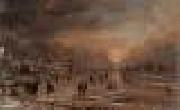 |
NEER, Aert van der
|
|
Dutch Baroque Era Painter, ca.1603-1677
Dutch landscape painter. Working mostly in Amsterdam, he excelled in painting unusual light effects, such as moonlight, sunsets, conflagrations, and glimmering light on snow and ice. His winter landscapes are among the best in Dutch art. He is well represented in many European galleries. The Metropolitan Museum has his Sunset, The Farrier, and Landscape. His son and pupil, Eglon Hendrik van der Neer, 1634C1703, was a genre, landscape, and portrait painter. He was court painter to the elector palatine in Desseldorf. He excelled in painting luxurious interiors, hunting scenes, and mythological or biblical subjects in Dutch settings.
|
|
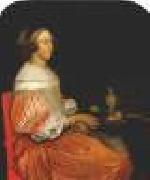 |
NEER, Eglon van der
|
|
Dutch Baroque Era Painter, ca.1634-1703
Son of Aert van der Neer. His birth date is based on Houbraken's statement that the artist was 70 years old when he died. He apparently studied first with his father and then with the genre and history painter Jacob van Loo. According to Houbraken, van der Neer was in France c. 1654, where he served as painter to the Counts of Dona, Dutch governors of the principality of Orange. He returned to Holland by 1659 and is recorded as a resident of Amsterdam at the time of his marriage to Maria van Wagensvelt in Rotterdam on 20 February 1659. |
|
|
|
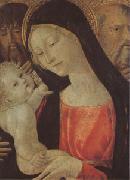 |
Neroccio di Bartolomeo
|
|
1447 - 1500
was an Italian painter and sculptor of the early-Renaissance or Quattrocento period in Siena. He was a student of Vecchietta, and then he shared a workshop with Francesco di Giorgio from 1468. He painted Scenes from the life of St Benedict, now in the Uffizi, probably in collaboration with di Giorgio, and a Madonna and Child between Saint Jerome and Saint Bernard, which is in the Pinacoteca of Siena. In 1472 he painted an Assumption for the abbey of Monte Oliveto Maggiore, and in 1475 he created a statue of Saint Catherine of Siena for the Sienese church dedicated to her. He separated from di Giorgio in 1475. In 1483, he designed the Hellespontine Sybil for the mosaic pavement of the Cathedral of Siena, |
|
|
|
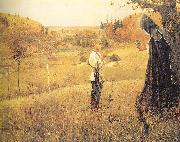 |
Nesterov, Mikhail
|
|
Russian, 1862-1942
Russian painter. From 1877 to 1881 and again from 1884 to 1886 he studied at the Moscow School of Painting, Sculpture and Architecture under the Realist painters Vasily Perov and Illarion Pryanishnikov. Between 1881 and 1884 he worked under Pavel Chistyakov (1832-1919) at the Academy of Arts, St Petersburg. At the estate of Savva Mamontov at Abramtsevo he met the most influential painters of the period, then at the epicentre of the development of Russian Art Nouveau. Nesterov sought to combine this style with a deep Orthodox belief; however, in his desire to revive religious art he was influenced more by French Symbolism, particularly by Bastien-Lepage, than by old Russian icon painting. All of Nesterov's canvases are marked by a lyrical synthesis between the figures and their landscape surroundings, as in Hermit (1888-9; Moscow, Tret'yakov Gal.), which shows the stooped figure of an old man against a northern landscape of stunted trees and still water. The large oil painting Vision of Young Bartholomew (1889-90; Moscow, Tret'yakov Gal.) depicts the legend of the childhood of the Russian saint Sergey of Radonezh. A monk appears to the young Bartholomew (the future St Sergius) and prophesies a glorious future for him. |
|
|
|
|
|
|
|
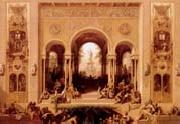 |
NEUREUTHER, Eugen
|
|
German painter b. 1806, Mnchen, d. 1882, Menchen,German lithographer, illustrator, decorative artist and painter. He was the son of the painter and printmaker Ludwig Neureuther (d 1832), and began his studies in Munich in 1823. His tutors included Peter von Cornelius, who enlisted him and several other young painters to help decorate the Glyptothek, and Wilhelm von Kobell. In 1830, fired with enthusiasm for the July Revolution in France, Neureuther went to Paris. He produced numerous studies from life (Munich, Staatl. Graph. Samml.), which are among his best works. From 1836-7 he was in Rome. From 1848 to 1856 he ran the Nymphenburg Porzellanmanufaktur, and for ten years from 1868 he taught decorative mural painting at the Munich Kunstgewerbeschule. Neureuther's principal importance lay in the field of book illustration. His reputation was established with the Vignettes for Goethe's Ballads and Romances (Randzeichnungen zu Goethes Balladen und Romanzen), published by J. G. Cotta in five booklets of 46 lithographic contour drawings in Munich, Stuttgart and Tebingen between 1829 and 1839. Goethe, to whom Cornelius had mentioned Neureuther, repeatedly spoke of these works in public, realizing their similarity to the prayer book of the Emperor Maximilian illustrated by Albrecht Derer, Lukas Cranach the elder, Hans Baldung, Albrecht Altdorfer and others. A new edition of this work, with lithographs by August Strixner (b 1820) had appeared in 1808. Neureuther later illustrated many other texts, but his approach became increasingly naturalistic and picturesque, and there was a notable decline in the artistic standard of the work. |
|
|
|
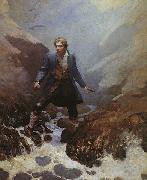 |
Newell Convers Wyeth
|
|
Newell Convers Wyeth (October 22, 1882 - October 19, 1945), known as N.C. Wyeth, was an American artist and illustrator. He was the pupil of artist Howard Pyle and became one of America's greatest illustrators. During his lifetime, Wyeth created over 3,000 paintings and illustrated 112 books, 25 of them for Scribner's, the Scribner Classics, which is the work for which he is best-known. The first of these, Treasure Island, was his masterpiece and the proceeds paid for his studio. Wyeth was a realist painter just as the camera and photography began to compete with his craft. Sometimes seen as melodramatic, his illustrations were designed to be understood quickly. Wyeth, who was both a painter and an illustrator, understood the difference, and said in 1908, "Painting and illustration cannot be mixedeone cannot merge from one into the other."
|
|
|
|
|
|
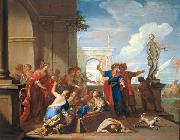 |
Niccolo Bambini
|
|
(1651-1736) was an Italian painter of the late-Renaissance and early-Baroque periods.
He was born in Venice, and first studied under Giulio Mazzoni at Venice; but afterwards went to Rome, where he became a pupil of Carlo Maratti. He painted for the church of San Stefano soon after his return from Rome. He died in Venice. He had two sons who were painters, Giovanni and Stefano. |
|
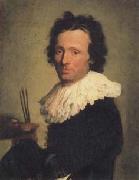 |
Niccolo Cassana
|
|
Italian , 1659 - 1714
was an Italian painter born in Venice and active during the late-Baroque. He trained with his father, Giovanni Francesco Cassana, a Genoese painter, who had been taught the art of painting by Bernardo Strozzi. He painted a "Conspiracy of Catiline" for the Gallery at Florence. Having painted portraits of the Florentine court, and also of some of the English nobility, Nicoletto was invited to England, and introduced to Queen Anne, who sat to him for her likeness, and conferred on him many marks of favour. He died in London in 1714 |
|
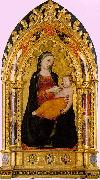 |
Niccolo di Pietro Gerini
|
|
Italian Painter, active ca.1368-1415
died in Florence in 1415, earned reputation of an important Italian painter. He represents giottesque school, in the tradition of the Andrea di Orcagna (1320-1368) and of Taddeo Gaddi. His father Pietro Geri is registered as a member of Lucas Guild in 1339. Niccolo worked mainly in Florence, although he also carried out commissions in Rome (Vatican), Pisa and Prato.
He was first recorded in 1368 as a member of the Arte dei Medici e Speziali in Florence but is identifiable with the Niccolo dipintore who collaborated with Jacopo di Cione on frescoes for the Guildhall of the Judges and Notaries in Florence in 1366. It is self-evident that he is the Niccolaio dipintore who worked with Jacopo di Cione on the altarpiece of the Coronation of the Virgin (presently in London, National Gallery) for St Pier Maggiore, Florence in 1370 and was paid 12 golden florins per disegnare la tavola dell altare in November of the same year. He designed the altarpiece and the elaborate throne canopy with his usual fine painting and detailed ornaments whilst Jacopo di Cione was depicting side saints. This altarpiece is amongst of very few largest commissioned in 14th century Florence. It was seemingly commissioned by Albizzi family.
He was collaborating with Jacopo di Cione on Coronation of the Virgin (Accademia, Florence) in 1372. Offner and Steinweg suggest that he was responsible for the design and fine painting and Jacopo for the execution of saints. It was commissioned by the mint of Florence Zecca Vecchia on the same year.
In 1383 Gerini again worked with Cione on a fresco of the Annunciation in the Palazzo dei Priori, Volterra. This fresco clearly shows the work of two very different artists: Niccolo di Pietro Gerini (design and very fine painting) and Jacopo di Cione (broadly painted saints and side decoration). In 1386 Niccolo frescoed the façade of the Bigallo, Florence. He also frescoed Sant Ambrogio church in Florence
Gerini performed the Crocefissione of St Felicita church in Florence.
His hand is clearly on sacrestia of the basilica of Saint Croce to Florence with Scenes of the life of Christ. Between 1391 and 1392 he worked in Prato where he frescoed Palazzo Datini, church of Saint Francisco with Lorenzo di Niccolo and Agnolo Gaddi.
He also frescoed capitolare of the church of Saint Francisco, Pisa.
Very typically for Gothic depiction Gerini figures have large chins, sloping foreheads, and sharp noses whilst their bodies are squat and frontally displaced.
Another important artist Lorenzo di Niccol?? di Martino was trained in Niccol?? di Pietro Gerini workshop and later collaborated with the master but was not his son as sometimes erroneously stated. Gerini though had a son Bindo di Niccolo di Pietro Gerini, born in 1363, who is registered as member of Lucas Guild since 1408.
Niccolo di Pietro Gerini works can be found in major art galleries of Rome, Vatican, Florence, London, Milan, New York, Los Angeles, Amsterdam, Berlin, Paris, St Petersburg, Boston, Cambridge, Budapest, Birmingham, Pegalo, Prato, Pisa, Altenburg, Avignon, Denver and several other museums. |
|
|
|
|
|
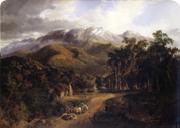 |
Nicholas Chevalier
|
|
Russia landscape artists and cartoonist .
1828-1902
was an Australian artist. Chevalier was born in St Petersburg, Russia, the son of Louis Chevalier, who came from Vaud, Switzerland, and was overseer to the estates of the Prince de Wittgenstein in Russia. Nicholas' mother was Russian. Nicholas left Russia with his father in 1845, and studied painting and architecture in Lausanne, Switzerland and at Munich. In 1851 Chevalier moved to London and worked as an illustrator in lithography and water-colour. He also designed a fountain which was erected in the royal grounds at Osborne, and two of his paintings were hung at the Academy in 1852. Further study in painting followed at Rome. About the end of 1854 Chevalier sailed from London to Australia to join his father and brother, and in August 1855 obtained work as a cartoonist on the newly established Melbourne Punch. Later he did illustrative work for the Illustrated Australian News and also worked in chromo-lithography. In 1864, when the National Gallery of Victoria was founded, an exhibition of pictures by Victorian artists was held, the government underook to buy the best picture exhibited for £200. Chevalier's oil painting "The Buffalo Ranges" was selected, and was the first picture painted in Australia to be included in the Melbourne collection. In 1867 Chevalier visited New Zealand, travelling widely and doing much work there which was exhibited at Melbourne on his return. In 1869 he joined the H.M.S. Galatea as an artist with the Duke of Edinburgh, on the voyage to the East and back to London with stops in Tahiti, Hawaii, Japan, China, Ceylon (Sri Lanka) and India. The pictures painted during the voyage were exhibited at South Kensington. In January 1874 Chevalier was commissioned by Queen Victoria to travel to St Petersburg and paint a picture of the marriage of the Duke of Edinburgh. Chevalier made London his headquarters and was a constant exhibitor at the Academy from 1871 to 1887. |
|
|
|
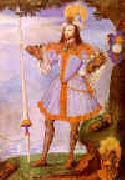 |
Nicholas Hilliard
|
|
1547-1619
British
Nicholas Hilliard Galleries
Nicholas Hilliard (c. 1547?CJanuary 7, 1619) was an English goldsmith and limner best known for his portrait miniatures of members of the courts of Elizabeth I and James I of England. He mostly painted small oval miniatures, but also some larger cabinet miniatures, up to about ten inches tall, and at least the two famous half-length panel portraits of Elizabeth. He enjoyed continuing success as an artist, and continuing financial troubles, for forty-five years, and his paintings still exemplify the visual image of Elizabethan England, very different from that of most of Europe in the late sixteenth century. Technically he was very conservative by European standards, but his paintings are superbly executed and have a freshness and charm that has ensured his continuing reputation as "the central artistic figure of the Elizabethan age, the only English painter whose work reflects, in its delicate microcosm, the world of Shakespeare's earlier plays. |
|
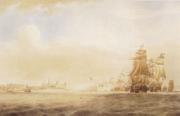 |
Nicholas Pocock
|
|
British Painter,
1741-1821
English painter. After an apprenticeship in the Bristol shipbuilding yards of Richard Champion, Pocock began a career at sea in the mid-1760s. He was a practised and gifted amateur watercolourist (his earliest signed and dated watercolour is from 1762), and when in command of the Lloyd, one of Champion's merchantmen, he began to keep detailed logbooks illustrated with wash drawings (four at London, N. Mar. Mus.). In 1780 he gave up his sea career, married and sent his first oil painting to the Royal Academy. The picture arrived too late for exhibition, but Sir Joshua Reynolds wrote back, noting 'It is much beyond what I expected from a first essay in oil colours'. Pocock exhibited annually at the Academy between 1782 and 1812 and enjoyed a steady supply of commissions for oil paintings and watercolours, mostly of marine subject-matter. He produced a series of watercolour views of Bristol (stylistically close to Edward Dayes) in the 1780s, many of which were engraved, and of Iceland in 1791. |
|
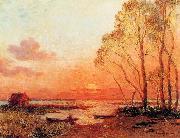 |
Nicholas Roerich
|
|
(Russian: ,October 9, 1874 - December 13, 1947), was a Russian mystic, painter, philosopher, scientist, writer, traveler, and public figure. A prolific artist, he created thousands of paintings (many of them are exhibited in well-known museums of the world) and about 30 literary works. Roerich was an author and initiator of an international pact for the protection of artistic and academic institutions and historical sites (Roerich's Pact) and a founder of an international movement for the defence of culture. Roerich earned several nominations for the Nobel Prize. |
|
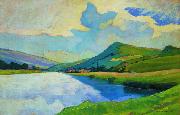 |
Nico Klopp
|
|
Den Nico Klopp war e letzebuergesche Moler. Hien ass den 18. September 1894 zu Bech-Maacher gebuer, an den 29. Dezember 1930 an der Stad Lëtzebuerg gestuerwen, wahrscheinlech un engem Gehirtumor, am Alter vun nëmme 36 Joer. Hie gëtt zu de postimpressionistesche Moler gerechent.
Säi LiewenDen Nico Klopp koum aus dem Wënzermilieu. Hien huet d'Handwierkerschoul an der Stad besicht. Seng Eltere si frei gestuerwen. No hirem Doud, huet hie sech fräi gefillt, fir vun 1915-1920 zu Dusseldorf a Weimar Konscht ze studeieren. Well hie vun der Konscht aleng net liewe konnt, war hien, vun 1923 un, Gemengereceveur zu Reimech.
Zäitweileg huet hien op Schoulen Zeechenunterrecht ginn, an huet nach en Täschegeld als Kannengerchersziichter verdengt. 1927 huet hie sech mat e puer anere Kënschtler, wei dem Joseph Kutter, dem Claus Cito, dem Auguste Tremont an anere vum Cercle Artistique getrennt, well him de Cercle ze reckstänneg war. Si goufe Sezessioniste genannt, well se 1927 e Salon de la Secession" organiseiert haten.
E puer vu senge Wierker sinn am Nationalmusee fir Geschicht a Konscht an der Stad ze gesinn.
Den Nico Klopp huet vill Biller vun der Musel gemoolt, bekannt si virun allem seng Biller vun der Muselbreck zu Reimech. Hien huet och Blummebiller gemoolt an dobäi hat hien eng Präferenz fir Tulpen. Ausserdeem war hien e Meeschter an Holz- a Linoschnëtter. |
|
|
|
|
|
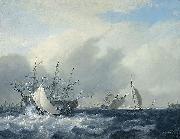 |
Nicolaas Baur
|
|
who was born at Harlingen in 1767, was the son of Hendricus Antonius Baur, a portrait painter (born 1736, died 1817). He painted landscapes and views of cities, and many houses in Holland are embellished by his works. He also painted moonlight and winter scenes; and was particularly successful in marine subjects. He is considered one of the best of the later Dutch marine painters. He died at Harlingen in 1820.
|
|
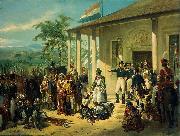 |
Nicolaas Pieneman
|
|
(1 January 1809, Amersfoort - 30 December 1860, Amsterdam) was a Dutch painter and lithographer. His father, Jan Willem Pieneman, was also a painter. Nicolaas Pieneman was a friend of William II of the Netherlands, whom he painted during his inauguration in 1840 |
|
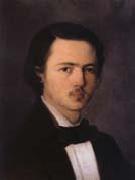 |
Nicolae Grigorescu
|
|
Romanian Painter, 1838-1907
From 1848 he trained in Bucharest with various church painters, producing icons and religious mural decorations. These works, which soon attracted attention, were influenced in style by the Viennese classicism widespread in the Romanian principalities in the early 19th century and by the Italian academicism established there after 1850 by Gheorghe Tattarescu. The earliest of his known paintings are in the church of SS Constantin and Elena at Baicoi, where his signature can be seen beside that of Nita Pereescu on the icon of St George (1853). He subsequently painted a series of icons (1854-5) at Caldarusani Monastery. In the later ensembles he was assisted by his older brother Georghe Grigorescu, who participated under his direction in the decoration of churches, such as those of the Zamfira (1856-8) and Agapia (1858-60) monasteries. In Nicolae's paintings at Agapia, classicism in Romanian art reached its highest point. The royal icons are distinguished for the elegance of the figures, both in their attitudes and in their drapery. |
|
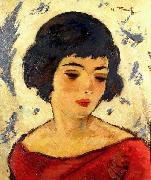 |
Nicolae Tonitza
|
|
(Romanian pronunciation: [nikoˈla.e toˈnit͡sa]; April 13, 1886 - February 27, 1940) was a Romanian painter, engraver, lithographer, journalist and art critic. Drawing inspiration from Post-impressionism and Expressionism, he had a major role in introducing modernist guidelines to local art.
Born in Bârlad, he left his home town in 1902 in order to attend the Iaşi National School of Fine Arts, where he had among his teachers Gheorghe Popovici and Emanoil Bardasare.The following year he visited Italy together with University of Bucharest students of archeology under the direction of Grigore Tocilescu.During that period, together with some of his fellow students, Tonitza painted the walls of Grozeşti church.
In 1908 he left for Munich, where he attended the Royal Academy of Fine Arts; he began publishing political cartoons in Furnica, and contributing art criticism articles to Arta Română. Tonitza spent the following three years in Paris, where he visited artists' studios, and studied famous paintings.Although the young artist's creation would initially conform to the prevalent style, his gift for colour and his personal touch would eventually lead him towards experiment.Throughout his life, he remained committed to the Munich School, hailing its innovative style over the supposedly "obscure imitators of Matisse".
|
|
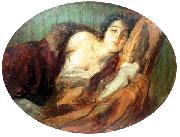 |
Nicolae Vermont
|
|
(October 10, 1866 - June 14, 1932) was a Romanian realist painter, graphic artist and muralist. He was noted for his wide range of subjects and his interest in social issues, and was an associate of the post-Impressionists Ştefan Luchian and Constantin Artachino, as well as a friend of the controversial art collector and political figure Alexandru Bogdan-Piteşti.
Born in Bacău, Vermont belonged to the Jewish community. Late in his life, Vermont abandoned Judaism and converted to the Romanian Orthodox Church.
He began his career in 1884, as a contributor to the journal Universul, while studying with Theodor Aman at the Academy of Fine Arts in Bucharest (graduated 1886). Vermont completed his training at the Munich Akademie der Bildenden Kenste (1893). He was able to attend the latter institution after being endorsed by the major Romanian artist Nicolae Grigorescu. |
|
|
|
|
|
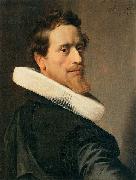 |
Nicolaes Eliaszoon Pickenoy
|
|
(10 January 1588 - 1653/1656) was a Dutch painter of Flemish origin. Pickenoy was possibly a pupil of Cornelis van der Voort and presumably Bartholomeus van der Helst was his own pupil.
He was the son of the Antwerp monumental mason Elias Claeszoon Pickenoy (1565-1640) and Heijltje Laurens s'Jonge (1562-1638), who emigrated to Amsterdam before Nicolaes Pickenoy was born. In 1621, living near the Oude Kerk, he married Levijntje Bouwens (1599-na 1656), an orphan of 21 years. They had ten children: Sara and Elias died young.
Pickenoy painted large Schuttersstukken, group portraits of the regents of the orphanage, and individual portraits of local or national celebrities like Nicolaes Tulp, Cornelis de Graeff, Maarten Harpertszoon Tromp and Jochem Hendrickszoon Swartenhont, Elisabeth Bas's husband. The earliest picture ascribed to the artist is "Dr. Sebastiaen Egbertz de Vrij's Osteological Presentation" of 1619, now in Amsterdam Historisch Museum. His heyday was ca. 1630-1637, a period marked by a high artistic level and numerous commissions from prominent patrons. After 1637 he painted little, save for a number of prestigiouseand lucrativeegroup portraits. Besides portraits, he also painted a small number of biblical subjects, one of which can be seen in the Museum Catharijneconvent. The Rijksmuseum Amsterdam and Amsterdams Historisch Museum holds many of his best works, not least the Schutterstukken or militia paintings.
In 1637 he bought from Adriaen Pauw the house on the corner of Sint Anthoniessluis and Jodenbreestraat, a fashionable area with many painters, art dealers, jewellers and so on. The house had previously been owned by his supposed master, Cornelis van der Voort, and later by Hendrick van Uylenburgh. During the years 1631-1634 the latter was collaborating with Rembrandt van Rijn, who painted numerous portraits for Van Uylenburgh's art business. Thus the house Pickenoy purchased had been a centre of Amsterdam portraiture for decades. In 1639 Rembrandt returned to the neighbourhood as he bought the house next to Pickenoys, the present day Rembrandthuis. Rembrandt could leave his house via an exit onto the Zwanenburgwal under the house of his neighbor Pickenoy. He brought out Night Watchepainted in his courtyarderolled up through the tunnel. Like Rembrandt, Pickenoy was not able to bring up the loan and so after eight years he sold the house.
The work of Pickenoy is difficult to distinguish from that of some of his contemporaries. Typical of Pickenoy are the fiercely invading light that makes the heads stand out sharply, the somewhat exaggerated gestures, the large greenish brown shadows and the odd-shaped eyes.
|
|
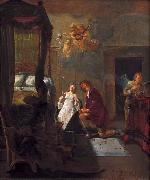 |
Nicolaes Knupfer
|
|
(1609 - 1655) was a Dutch Golden Age painter.
Knepfer was trained in Leipzig, where according to Houbraken he was apprenticed to Emanuel Nysen. He then moved to Magdeburg where he found work making brushes for artists. He stayed there until 1630, and then moved to Utrecht to work with Abraham Bloemaert. He lived with him for two years and then established his own studio in Utrecht, where in 1637 he became a visiting member of the Guild of St. Luke. He worked on the decorations of the castle Kronborg in Denemarken, and painted figures in the landscapes of Jan Both and Jan Baptist Weenix. Knepfer was a successful teacher, whose students were great painters after him, such as Jan Steen, Gabriel Metsu, Ary de Vois, and Pieter Crijnse Volmarijn.
|
|
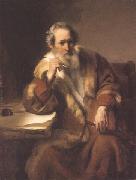 |
Nicolaes maes
|
|
Dutch Baroque Era Painter, 1634-1693
Dutch painter. The son of the prosperous Dordrecht merchant Gerrit Maes and his wife Ida Herman Claesdr., Nicolaes Maes learnt to draw from a 'mediocre master' (Houbraken) in his native town before he studied painting with Rembrandt in Amsterdam. His training in Rembrandt's studio must have taken place between 1648/50 and 1653. By December 1653 Maes had settled in Dordrecht and made plans to marry, while a signed and dated picture of 1653 confirms that the 19-year-old artist had completed his training and embarked on an independent career. |
|
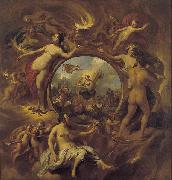 |
Nicolaes Pietersz. Berchem
|
|
(1 October 1620 - 18 February 1683) was a highly esteemed and prolific Dutch Golden Age painter of pastoral landscapes, populated with mythological or biblical figures, but also of a number of allegories and genre pieces.
Born in Haarlem, he received instruction from his father Pieter Claesz, and from the painters Jan van Goyen, Pieter de Grebber, Jan Baptist Weenix, Jan Wils and Claes Cornelisz. Moeyaert.According to Houbraken, Carel de Moor told him that Berchem got his name from two words "Berg hem" for "Save him!", an expression used by his fellows in Van Goyen's workshop whenever his father chased him there with the intent to beat him. No trip or Grand Tour by Berchem was documented by Houbraken though he mentioned another story about the "Berg hem!" nickname which came from Berchem's conscription as a sailor; the man in charge of impressment knew him and sent him ashore with the words "Save him!".Today his name is assumed to come from his father's hometown of Berchem, Antwerp. According to the RKD he traveled to Italy with Jan Baptist Weenix, whom he called his cousin, in 1642-5. Works by him are signed both as "CBerghem" and "Berchem". |
|
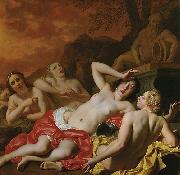 |
Nicolaes van Helt Stockade
|
|
(1614-1669), was a Dutch Golden Age painterAccording to Houbraken, Joost van den Vondel made a poem about him.
According to the RKD he became a master in the Antwerp Guild of Saint Luke in 1646 and worked on the city hall of Nijmegen and the Amsterdam City Hall.
|
|
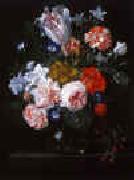 |
Nicolaes Van Verendael
|
|
Flemish
1640-1691
He became a member of Saint-Luc d Anvers craft in 1657. He did not paint lots of pictures and lived modestly. |
|
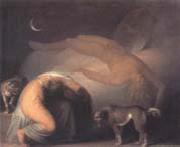 |
Nicolai Abildgaard
|
|
1743-1809 Romanticism,Danish,Danish painter, designer and architect. His paintings reveal both Neo-classical and Romantic interests and include history paintings as well as literary and mythological works. The variety of his subject-matter reflects his wide learning, a feature further evidenced by the broad range of his creative output. In addition to painting, he produced decorative work, sculpture and furniture designs, as well as being engaged as an architect. |
|
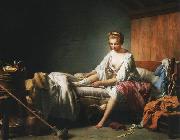 |
Nicolas Bernard Lepicie
|
|
was a French painter (16 June 1735 - 15 September 1784), the son of two reputed engravers at the time, Francois-Bernard and Renee-Elisabeth, was introduced to the artistic and cultural environment by his parents.
Nicolas-Bernard studied with reputed artists of the century including Carle Vanloo. In 1769 he was accepted to the Royal Academy of Painting and Sculpture in Paris. Three years later, in 1770, he became an assistant professor and, in 1777, a professor. Important names such as Carle Vernet, Jean-Frederic Schall, Jean-Antoine-Theodore Giroust, Jean-Joseph Taillasson, Henri-Pierre Danloux, Jean-Baptiste Regnault and Nicolas-Antoine. |
|
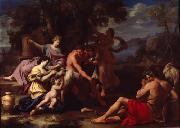 |
Nicolas Chaperon
|
|
Nicolas Chaperon (Châteaudun, bapt. 19 October 1612 e Lyon 1656) was a French painter, draughtsman and engraver, a student in Paris of Simon Vouet whose style he adopted before he was further matured by his stay in Rome (1642-51) in the studio of Nicolas Poussin.
In 1653-55 the consuls de Lyon called him to decorate the hôtel de ville but Chaperon dying almost as soon as he arrived, the commission passed to Thomas Blanchet. Chaperon made a name for himself with his suite of engravings after the Raphael Loggie of the Vatican, Rome, 1649, but art historians remember him for the stream of fulminating invective with which Poussin in his correspondence with Paul Freart de Chantelou described this unruly and vindictive practician who refused to carry through his copy of a Transfiguration. So little is known of Chaperon that this episode stands out. |
|
|

